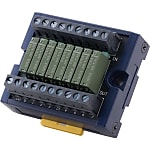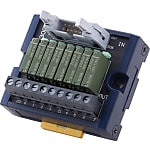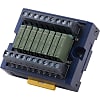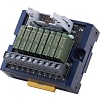(!) Since support from Microsoft will end on January 14th, 2020, Windows 7 will be excluded from the recommended environment from December 15th, 2019 on this site. Vì lý do Microsoft kết thúc hỗ trợ cho Windows 7 vào ngày 14/01/2020, Windows 7 sẽ là hệ điều hành không được khuyến khích sử dụng với trang web này từ ngày 15/12/2019.
Search by Category / Brand Tìm theo danh mục, nhãn hiệu
Search by Category Tìm theo danh mục
- [Thông báo] Cập nhật địa chỉ kho tập kết hàng hóa tại khu vực miền Nam của MISUMI Việt Nam. Xem chi tiết.
[Announcement] Update on warehouse address in the Southern region of MISUIMI Vietnam. See more. - [Cảnh Báo] Thủ Đoạn Lừa Đảo Từ Nhân Viên Giao Hàng – Yêu Cầu Trả Phí Ship. Xem chi tiết.
[Warning] Fraud Calling from Shipper - Asking to Pay Shipping Fee. See more.
MISUMI Terminal Relays
Brand |
|
|---|---|
| CAD |
|
| Days to Ship |
|
2 itemsMặt hàng
- Sort By
-
You can add up to 6 items per a category to the compare list.

RT-2 Relay Terminal 1a × 8 (terminal block connection)
MISUMI
Equipped with 8 Panasonic PA relays. Supports upper circuit operation with LED lighting
- Volume Discount
- CE-Compliant
- Connection in Boards
- Space-saving
- PLC
- CAD :
- 2D
From: 1,415,661 VND Days to Ship: Số ngày giao hàng: 4 Day(s) or more  4 Day(s) or more
4 Day(s) or more
-
You can add up to 6 items per a category to the compare list.

RT-2 Relay Terminal 1a × 8 (Connector/terminal block)
MISUMI
Equipped with 8 Panasonic PA relays. Supports upper circuit operation with LED lighting
- Volume Discount
- CE-Compliant
- Connection in Boards
- Space-saving
- PLC
- CAD :
- 2D
From: 959,146 VND Days to Ship: Số ngày giao hàng: 4 Day(s) or more  4 Day(s) or more
4 Day(s) or more
| BrandNhãn hiệu |
|---|
| Product SeriesDòng sản phẩm |
| CADCAD |
| From |
| Days to ShipSố ngày giao hàng |
| SpecificationsĐặc điểm kĩ thuật |
You can add up to 6 items per a category to the compare list. | You can add up to 6 items per a category to the compare list. | |
| BrandNhãn hiệu | MISUMI | MISUMI |
| Product SeriesDòng sản phẩm | ||
| CADCAD |
|
|
| From | 1,415,661 VND | 959,146 VND |
| Days to ShipSố ngày giao hàng | 4 Day(s) or more | 4 Day(s) or more |
| SpecificationsĐặc điểm kĩ thuật |
|
|
Loading...Tải…
ConfigureTạo
Related Categories to Terminal RelaysDanh mục liên quan đến Terminal Relays
FAQ Terminal Relays
- Question: How can you determine the terminals on a relay?
- Answer: 1. Datasheet Review: Examine the relay's datasheet for a diagram or labeled information. It typically includes designations like "Coil," "NO" (Normally Open), "NC" (Normally Closed), and possibly coil polarity markings like "A1" and "A2."
2. Visual Inspection: Examine the relay's case for symbols or markings indicating terminal functions. Sometimes, terminals are labeled directly on the relay. - Question: How does a 4-terminal relay differ from a 5-terminal relay?
- Answer: The primary difference between a 4-pin relay and a 5-pin relay lies in their ability to control multiple circuits.
A 4-pin relay is designed to control a single circuit. It has two pins for controlling the relay coil (85 and 86) and two pins for switching power on or off (30 and 87). The 30 pin is the source of power, and the 87 pin is the load to be controlled.
A 5-pin relay is designed to control two independent circuits. It has two pins for controlling the relay coil (85 and 86) and three pins for switching power on or off (30, 87a, and 87). The 30 pin is the source of power, the 87a pin serves as the normally open (NO) contact, and the 87 pin serves as the normally closed (NC) contact. This allows for switching between two separate circuits. - Question: What is the main part of a relay?
- Answer:
The main components of a relay are two:
1. The coil is the primary component of a relay. It is responsible for creating the magnetic field that attracts the contact.
2. Contact: It is a pair of metal pieces that are separated by a small gap. When the coil is energized, the magnetic field attracts the contact together, closing the gap. It works like a switch to control the direction of current flow to the desired device. - Question: What are the different types of relay terminals?
- Answer: Relays commonly have various terminals serving distinct purposes for example:
• NC terminal, which stands for 'Normal Closed,' means that the contact is normally closed. This means that the contact is connected to the C terminal even if the coil is not energized. We generally connect this terminal to devices or appliances that need to be powered on at all times.
• NO terminal, which stands for 'Normal Open,' means that the contact is normally open. This means that the contact is not connected to the C terminal even if the coil is not energized. We generally connect this terminal to devices or appliances that need to be powered on for a limited period of time only.
• C terminal, which stands for 'common,' is the common point that is connected to the power source.









How can we improve?
How can we improve?
While we are not able to respond directly to comments submitted in this form, the information will be reviewed for future improvement.
Customer Privacy Policy
Thank you for your cooperation.
While we are not able to respond directly to comments submitted in this form, the information will be reviewed for future improvement.
Please use the inquiry form.
Customer Privacy Policy